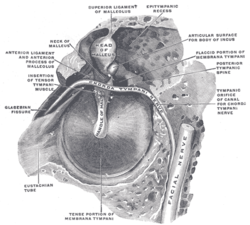Chorda tympani nerve
| Chorda tympani | |
|---|---|

The right membrana tympani with the hammer and the chorda tympani, viewed from within, from behind, and from above.
|
|
| Details | |
| From | facial nerve |
| Identifiers | |
| MeSH | A08.800.800.120.250.120 |
| TA |
A14.2.01.084 A14.2.01.118 |
| FMA | 53228 |
|
Anatomical terms of neuroanatomy
[]
|
|
The chorda tympani is a branch of the facial nerve that originates from the taste buds in the front of the tongue, runs through the middle ear, and carries taste messages to the brain. It joins the facial nerve (cranial nerve VII) inside the facial canal, at the level where the facial nerve exits the skull via the petrotympanic fissure.
The chorda tympani is part of one of three cranial nerves that are involved in taste. The taste system involves a complicated feedback loop, with each nerve acting to inhibit the signals of other nerves. The chorda tympani appears to exert a particularly strong inhibitory influence on other taste nerves, as well as on pain fibers in the tongue. When the chorda tympani is damaged, its inhibitory function is disrupted, leading to less inhibited activity in the other nerves.
The chorda tympani exits the cranial cavity through the internal acoustic meatus along with the facial nerve, then it travels through the middle ear, where it runs from posterior to anterior across the tympanic membrane. It passes between the malleus and the incus, on the medial surface of the neck of the malleus.
The nerve continues through the petrotympanic fissure, after which it emerges from the skull into the infratemporal fossa. It soon joins the pathway of the larger lingual nerve, a branch of the mandibular nerve.
The fibers of the chorda tympani travel with the lingual nerve to the submandibular ganglion.
Here, the preganglionic fibers of the chorda tympani synapse with postganglionic fibers which go on to innervate the submandibular and sublingual salivary glands.
...
Wikipedia
